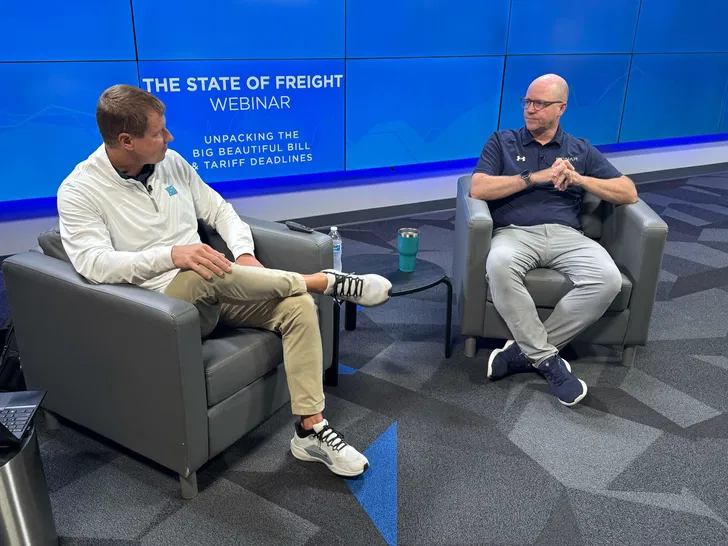Panoramica del mercato
Il mercato del trasporto merci ha mostrato dinamiche interessanti di recente, in particolare per quanto riguarda il volume e la capacità. Luglio ha rivelato alcune tendenze intriganti che fanno luce sullo stato della logistica e dei trasporti. Questo articolo approfondisce gli indicatori chiave e i risultati di un recente webinar, evidenziando aspetti critici che potrebbero influenzare il settore del trasporto merci.
Punti chiave dai trend di luglio
- Tendenze contraddittorie nei dati SONAR mostrano un indice di rifiuto delle offerte in uscita (OTRI) in aumento, contrastato da un indice del volume delle offerte in uscita (OTVI) in diminuzione. Ciò suggerisce una riduzione della capacità derivante da diverse uscite di vettori.
- La stagione degli utili ha messo in luce le sfide per le società di autotrasporto a lungo raggio come Heartland Express, contrapposte al notevole successo di Knight Swift nell'integrazione di U.S. Xpress. Questo cambiamento segnala un movimento verso la logistica a corto raggio.
- La fusione prevista tra Norfolk Southern e Union Pacific potrebbe avere profonde implicazioni per l'industria del trasporto merci, con i maggiori vettori intermodali che potrebbero potenzialmente trarne vantaggio, mentre gli operatori più piccoli potrebbero affrontare delle sfide.
- Un rinnovato entusiasmo per la tecnologia del trasporto merci, in particolare per le soluzioni guidate dall'intelligenza artificiale (IA), sta stimolando una maggiore attività in questo settore.
Trend sulla capacità: indici in aumento, volumi in calo
I dati attuali di SONAR indicano due tendenze cruciali: l'OTRI è in aumento, suggerendo una contrazione della capacità, mentre l'OTVI è in calo. Mentre una diminuzione del volume delle gare d'appalto è in linea con le continue contrazioni del mercato, l'aumento dei rifiuti indica che gli operatori indipendenti stanno togliendo i loro camion dalle strade. Questo fenomeno è attribuito a vari fattori, tra cui le misure di applicazione che stanno influenzando il numero di camionisti attivi.
Mentre Fuller, uno dei relatori principali, ha notato che la capacità è rimasta relativamente stabile per diversi anni, le recenti tendenze che accostano la crescita della capacità con l'aumento delle revoche di autorizzazioni dipingono un quadro diverso. Strickland, un altro relatore, ha discusso di come la Drug & Alcohol Clearinghouse potrebbe contribuire a questo aumento delle revoche di autorizzazioni dei vettori, segnalando potenziali sfide future.
Approfondimenti sulla stagione degli utili
L'analisi di luglio ha coinciso con la stagione degli utili, in cui le società di logistica hanno condiviso i risultati delle loro performance trimestrali. In particolare, Heartland Express ha riportato un continuo declino, influenzato da strategie obsolete più adatte a un precedente panorama aziendale a lungo raggio.
Riflettendo sulla sua storia familiare con U.S. Xpress, Fuller ha condiviso approfondimenti sulle sfide affrontate. La traiettoria di U.S. Xpress dopo l'acquisizione da parte di Knight Swift illustra come l'adattamento all'ambiente attuale sia essenziale. Knight Swift è riuscita a migliorare i margini operativi di U.S. Xpress, dimostrando che l'adattabilità strategica può portare alla ripresa.
L'ascesa della logistica a corto raggio
Passando dal lungo raggio al corto raggio, il panorama della logistica è in evoluzione. Osservazioni da SONAR illustrano che attualmente, gli indici per la logistica a corto raggio hanno superato quelli per il trasporto a lungo raggio, una tendenza che Fuller considera indicativa di cambiamenti di mercato di lunga data.
Motivo di preoccupazione per il settore degli autotrasporti è la crescente dipendenza dalle importazioni nella logistica a lungo raggio, dove le merci vengono spesso trasportate tramite trasporto containerizzato su rotaie anziché su camion. Questa tendenza potrebbe rimodellare in modo significativo le strategie di trasporto in futuro.
Impatto futuro delle fusioni
La potenziale fusione tra Norfolk Southern e Union Pacific solleva interrogativi sui suoi effetti sul panorama logistico. Sebbene tale consolidamento possa snellire le operazioni e aumentare la redditività per i caricatori più grandi, potrebbe anche porre sfide per gli operatori ferroviari tradizionali e le imprese di logistica più piccole.
Il consolidamento potrebbe portare a servizi migliorati per i principali vettori intermodali, ma potrebbe diminuire la qualità del servizio per i tradizionali spedizionieri che dipendono da materie prime alla rinfusa come carbone o cereali. Fuller ha affermato che, mentre le aziende più grandi potrebbero trarne vantaggio, gli operatori più piccoli e i proprietari-autisti potrebbero trovarsi estromessi dal panorama competitivo.
Tecnologie emergenti nel trasporto merci
In mezzo a questi cambiamenti, l'interesse per la tecnologia nel settore del trasporto merci sta vivendo una ripresa, in particolare con i progressi nell'IA. Fuller ha osservato che prima della pandemia era emersa un'ondata di innovazioni tecnologiche nel settore del trasporto merci, sostenuta dal sostegno del capitale di rischio.
Gli sviluppi attuali, come l'acquisizione di Greenscreens AI da parte di Triumph Financial, esemplificano questo rinnovato interesse. Con numerose tecnologie emergenti che forniscono soluzioni innovative, il settore della logistica è sull'orlo della trasformazione, sbloccando nuove potenzialità per l'efficienza e l'affidabilità.
Spunti di riflessione conclusivi
Il panorama in evoluzione del trasporto merci e della logistica è indubbiamente complesso. L'analisi di luglio riflette che sono in corso cambiamenti significativi e, anche se le revisioni e le proiezioni forniscono preziose informazioni, l'esperienza personale rimane insuperabile.
Per chi si orienta nel settore della logistica, GetTransport.com offre una piattaforma in grado di semplificare il trasporto di merci a livello globale a tariffe competitive. Con un'enfasi sull'economicità e la trasparenza, GetTransport.com soddisfa un'ampia gamma di esigenze di trasporto, sia per consegne di merci, traslochi di uffici o traslochi personali.
Per riassumere, gli sviluppi discussi sottolineano l'importanza dell'adattabilità e della tecnologia nel plasmare il futuro della logistica e dei trasporti. Abbraccia questo panorama in evoluzione, e prenota il tuo trasporto merci con GetTransport.com per semplificare la tua logistica oggi! GetTransport.com.com

 Approfondimenti sul mercato del trasporto merci di luglio: tendenze e indicatori chiave">
Approfondimenti sul mercato del trasporto merci di luglio: tendenze e indicatori chiave">